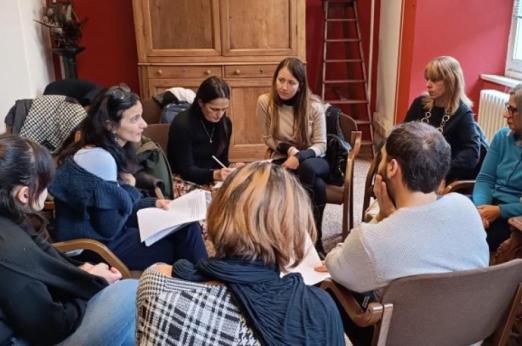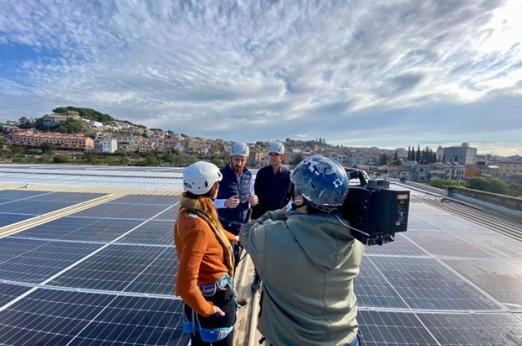URBACT are o vastă experiență în sprijinirea orașelor pentru a-și îmbunătăți politicile urbane prin cooperare transnațională. Abordarea „de jos în sus” a programului permite orașelor să își definească propriile nevoi, asigurând în același timp o legătură puternică cu cadrul politicii de coeziune. În perioada 2021-2027, URBACT va promova dezvoltarea urbană durabilă integrată prin cooperare și va contribui, de asemenea, la o Europă mai aproape de cetățeni (PO5). Mai precis, URBACT poate ajuta mai multe orașe să își dezvolte capacitățile de a concepe și furniza planuri și strategii de dezvoltare urbană durabilă.
Programul Interreg URBACT IV va opera sub un singur obiectiv specific Interreg 1 (ISO1): o mai bună guvernanță a cooperării prin consolidarea capacității instituționale a autorităților publice și a părților interesate de a implementa strategii teritoriale urbane și va avea o singură axă prioritară: Promovarea dezvoltării urbane durabile integrate prin cooperare.

- 6258Plan Einstein AcademyOngoingInnovation Transfer Network933, 300, 1694, 866, 973, 987866Suceava47.651389, 26.255556Romania
- 62502NiteOngoingInnovation Transfer Network897, 1536, 298, 768, 1700298Cluj-Napoca46.766667, 23.583333Romania
- 4673S.M.ALLOngoingAction Planning Network1430, 523, 503, 1536, 843, 331, 374, 1411, 16261626Bucharest Metropolitan Area Intercommunity Development Association44.435884586987, 26.099431242013Romania
- 4671Remote-ITOngoingAction Planning Network1559, 448, 1620, 238, 879, 628, 1576, 15531576Bucharest 6th district44.434503552501, 26.034120374502Romania
- 4667Residents of the futureOngoingAction Planning Network829, 131, 1621, 798, 718, 1622, 1623, 796, 578, 1624131Alba Iulia46.066944, 23.57Romania
- 4664SCHOOLHOODSOngoingAction Planning Network1608, 434, 915, 1609, 986, 702, 241, 16101609Brasov Metropolitan Agency for Sustainable Development45.644048357211, 25.588905635479Romania
- 4665One Health 4 CitiesOngoingAction Planning Network566, 866, 374, 1611, 559, 1612, 1613, 355, 621866Suceava47.651389, 26.255556Romania
- 4663NextGen YouthWorkOngoingAction Planning Network352, 120, 272, 458, 499, 686, 709, 1433, 955, 963458Iași47.156944, 27.590278Romania
- 4660GreenPlaceOngoingAction Planning Network979, 655, 1423, 1547, 1597, 1598, 1626, 1599, 1600, 5421626Bucharest Metropolitan Area Intercommunity Development Association44.435884586987, 26.099431242013Romania
- 4658GenProcureOngoingAction Planning Network961, 987, 511, 591, 1594, 921, 1654, 1549, 15961594Satu Mare County Intercommunity Development Association47.790356, 22.874042Romania
- 4657FEMACT-CitiesOngoingAction Planning Network295, 1592, 1593, 300, 897, 522, 512, 15501550Cluj Metropolitan Area - Intercommunity Development Association46.769921, 23.595024Romania
- 4654COPEOngoingAction Planning Network303, 485, 1571, 221, 796, 307, 509, 968221Bistrița47.133333, 24.5Romania
- 4652TechDiversityOngoingAction Planning Network911, 152, 217, 434, 524, 1583, 169, 1576, 4601576Bucharest 6th district44.434503552501, 26.034120374502Romania
- 4651U.R. ImpactOngoingAction Planning Network1391, 217, 1578, 1429, 1390, 1579, 555, 1577, 628, 15751575Târgu Frumos47.212364768973, 27.005338464268Romania
- 4650WELDIOngoingAction Planning Network933, 850, 391, 132, 895, 298, 680, 1572, 538, 1573895Timisoara45.753959, 21.227607Romania
- 4650WELDIOngoingAction Planning Network933, 850, 391, 132, 895, 298, 680, 1572, 538, 1573298Cluj-Napoca46.766667, 23.583333Romania
- 4653Breaking IsolationOngoingAction Planning Network123, 468, 825, 1570, 1571, 1574, 1580, 1411, 1581, 15821574Roman46.925392, 26.927494Romania
- 4647EcoCoreOngoingAction Planning Network189, 1559, 1560, 131, 489, 811, 703, 1561, 1562131Alba Iulia46.066944, 23.57Romania
- 4638LET'S GO CIRCULAR!OngoingAction Planning Network621, 768, 1550, 435, 1551, 421, 686, 1552, 574, 15531550Cluj Metropolitan Area - Intercommunity Development Association46.769921, 23.595024Romania
- 4637DIGI-INCLUSIONOngoingAction Planning Network606, 470, 137, 901, 1546, 458, 1547, 1548, 1549458Iași47.156944, 27.590278Romania
- 4627Beyond the UrbanOngoingAction Planning Network1531, 808, 455, 1532, 1533, 879, 1534, 1535, 1410, 16361535Bucharest-Ilfov Intercommunity Development Association for Public Transport44.430078, 26.102087Romania
- 4625Agents of Co-ExistenceOngoingAction Planning Network1413, 399, 489, 250, 1416, 1642, 1530, 120, 2341642The Intercommunity Development Association of the Iași Metropolitan Area47.15975438228, 27.598628009556Romania
- 3813Resourceful CitiesClosedAction Planning Network891, 585, 704, 292, 987, 681, 961, 247, 259, 676247Bucharest 3rd district44.426767, 26.102538Romania
- 772URBinclusionClosedImplementation Network194, 303, 415, 512, 566, 637, 895, 911, 114895Timisoara45.753959, 21.227607Romania
- 770INT-HERITClosedImplementation Network131, 185, 262, 328, 367, 578, 683, 832, 892131Alba Iulia46.066944, 23.57Romania
- 766BoostInnoClosedAction Planning Network187, 194, 229, 399, 522, 599, 701, 862, 114, 979187Baia Mare47.666667, 23.583333Romania
- 765Freight TAILSClosedAction Planning Network242, 401, 519, 567, 702, 853, 866, 877, 921, 976866Suceava47.651389, 26.255556Romania
- 763In FocusClosedAction Planning Network217, 41, 224, 246, 388, 427, 684, 718, 726, 114246Bucharest44.4325, 26.103889Romania
- 761ProcureClosedAction Planning Network132, 142, 223, 267, 505, 511, 562, 631, 734, 738, 814814Satu Mare47.79, 22.89Romania
- 757INTERACTIVE CITIESClosedAction Planning Network131, 297, 322, 407, 410, 628, 692, 823, 879, 943131Alba Iulia46.066944, 23.57Romania
- 756REFILLClosedAction Planning Network154, 175, 235, 298, 410, 446, 635, 684, 731, 768298Cluj-Napoca46.766667, 23.583333Romania
- 755RetaiLinkClosedAction Planning Network202, 221, 380, 447, 453, 463, 536, 706, 776, 829221Bistrița47.133333, 24.5Romania
- 752CityMobilNetClosedAction Planning Network126, 130, 216, 229, 256, 615, 692, 770, 839, 851, 986839Slatina44.430168, 24.37169Romania
- 750SmartImpactClosedAction Planning Network332, 352, 432, 576, 600, 726, 841, 860, 866, 987866Suceava47.651389, 26.255556Romania
- 749sub>urbanClosedAction Planning Network163, 187, 195, 241, 274, 341, 681, 844, 960187Baia Mare47.666667, 23.583333Romania
- 744BluActClosedTransfer Network255, 393, 580, 581, 682, 717, 800393Galati45.423333, 28.0425Romania
- 741Civic eStateClosedTransfer Network158, 194, 399, 410, 458, 637, 737458Iași47.156944, 27.590278Romania
- 738Innovato-RClosedTransfer Network298, 593, 628, 726, 783, 114, 955298Cluj-Napoca46.766667, 23.583333Romania
- 732RUMOURLESS CITIESClosedTransfer Network131, 151, 270, 442, 591, 973131Alba Iulia46.066944, 23.57Romania
- 731Tech RevolutionClosedTransfer Network183, 198, 668, 700, 717, 816, 967183Bacau46.583333, 26.916667Romania
- 724Thriving StreetsClosedAction Planning Network702, 163, 348, 462, 499, 662, 678, 745, 811, 553678Oradea47.072222, 21.921111Romania
- 716ROOFClosedAction Planning Network229, 410, 415, 538, 670, 731, 893, 895, 905895Timisoara45.753959, 21.227607Romania
- 711Space4PeopleClosedAction Planning Network216, 167, 184, 434, 640, 696, 795, 825, 915, 938167Arad46.18333, 21.31667Romania
- 708ActiveCitizensClosedAction Planning Network123, 221, 279, 325, 455, 796, 808, 880221Bistrița47.133333, 24.5Romania
- 707SIBdevClosedAction Planning Network120, 187, 391, 443, 487, 723, 971, 989187Baia Mare47.666667, 23.583333Romania
- 705Find your GreatnessClosedAction Planning Network117, 131, 230, 267, 542, 709, 971, 979131Alba Iulia46.066944, 23.57Romania
- 704Urb-En PactClosedAction Planning Network213, 290, 295, 347, 355, 393, 594, 693393Galati45.423333, 28.0425Romania
- 697CO4CITIESClosedInnovation Transfer Network251, 298, 399, 114298Cluj-Napoca46.766667, 23.583333Romania
- 702AS TRANSFERClosedInnovation Transfer Network217, 41, 879, 895895Timisoara45.753959, 21.227607Romania
- 703Zero Carbon CitiesClosedAction Planning Network221, 388, 576, 603, 879, 969, 986221Bistrița47.133333, 24.5Romania
- 706DigiPlaceClosedAction Planning Network226, 591, 686, 725, 778, 796, 911, 952226Botoşani47.75, 26.66667Romania
- 709Health&GreenspaceClosedAction Planning Network115, 234, 371, 542, 591, 731, 809, 866, 879866Suceava47.651389, 26.255556Romania
- 712FOOD CORRIDORSClosedAction Planning Network131, 244, 523, 754, 873, 879, 923131Alba Iulia46.066944, 23.57Romania
- 737Making Spend MatterClosedTransfer Network221, 485, 511, 695, 738, 815, 961221Bistrița47.133333, 24.5Romania
- 739Come in!ClosedTransfer Network386, 411, 718, 724, 917, 942, 973411Gheorgheni46.721211, 25.585527Romania
- 747ALT/BAUClosedTransfer Network288, 302, 768, 789, 824, 114, 965302Constanta44.173333, 28.638333Romania
- 743CARD4ALLClosedTransfer Network180, 296, 412, 476, 813, 866866Suceava47.651389, 26.255556Romania
- 745BioCanteensClosedTransfer Network520, 617, 780, 901, 911, 913, 944944Vaslui46.63833, 27.72917Romania
- 5583JobTown 2ClosedImplementation Network894, 223, 548, 532, 131, 492, 631131Alba Iulia46.066944, 23.57Romania
- 773Urban Green LabsClosedAction Planning Network116, 393, 443, 579, 680, 790, 801, 810, 968393Galati45.423333, 28.0425Romania
- 5582ESIMeC IIClosedAction Planning Network202, 791, 322, 221, 397221Bistrița47.133333, 24.5Romania
- 823CityLogoClosedAction Planning Network120, 131, 299, 336, 407, 681, 933, 968, 973, 989131Alba Iulia46.066944, 23.57Romania
- 818URBACT MarketsClosedAction Planning Network179, 194, 332, 706, 866, 904, 114, 976, 979866Suceava47.651389, 26.255556Romania
- 777Building Healthy CommunitiesClosedAction Planning Network153, 183, 187, 198, 206, 527, 537, 569, 114, 997187Baia Mare47.666667, 23.583333Romania
- 801LINKSClosedAction Planning Network144, 161, 203, 232, 254, 323, 387, 389, 494, 953232Brasov45.666667, 25.616667Romania
- 809REPAIRClosedAction Planning Network182, 285, 383, 480, 484, 588, 645, 675, 698, 782, 893182Avrig45.728829, 24.378438Romania
- 797MILEClosed151, 503, 641, 783, 827, 895, 114, 941, 951895Timisoara45.753959, 21.227607Romania
- 828Gastronomic CitiesClosedTransfer Network131, 256, 380, 509, 518131Alba Iulia46.066944, 23.57Romania
- 825EVUE IIClosedImplementation Network204, 388, 482, 681, 866, 976866Suceava47.651389, 26.255556Romania
- 794LUMASECClosedAction Planning Network187, 239, 258, 485, 566, 794, 925, 927187Baia Mare47.666667, 23.583333Romania
- 789SuiteClosedAction Planning Network441, 458, 512, 588, 635, 649, 762, 810, 877458Iași47.156944, 27.590278Romania
- 800ESIMeCClosedAction Planning Network132, 202, 211, 221, 289, 322, 398, 791221Bistrița47.133333, 24.5Romania
- 778CityRegion.NetClosedAction Planning Network169, 283, 318, 424, 492, 621, 678, 911, 994678Oradea47.072222, 21.921111Romania
- 831TUTURClosedTransfer Network131, 235, 777131Alba Iulia46.066944, 23.57Romania
- 790UNICClosedAction Planning Network180, 275, 298, 323, 377, 543, 706, 827, 861298Cluj-Napoca46.766667, 23.583333Romania
- 819USEAct Urban Sustainable Environmental ActionsClosedAction Planning Network187, 192, 248, 332, 637, 655, 768, 910, 963, 996187Baia Mare47.666667, 23.583333Romania
- 817RE-BlockClosedAction Planning Network116, 251, 405, 458, 570, 571, 755, 777, 801, 842, 968458Iași47.156944, 27.590278Romania
- 777Building Healthy CommunitiesClosedAction Planning Network153, 183, 187, 198, 206, 527, 537, 569, 114, 997183Bacau46.583333, 26.916667Romania
- 782My GenerationClosed163, 196, 219, 399, 415, 419, 704, 768, 783, 896, 936, 973896Tirgu-Mures46.545556, 24.5625Romania
- 786NeT-TOPICClosedAction Planning Network192, 436, 498, 518, 634, 792, 801, 826792Sacele45.62, 25.709722Romania
- 8224D CitiesClosedAction Planning Network188, 352, 463, 471, 528, 663, 720, 879188Baia Sprie47.660833, 23.688611Romania
- 783OPENCitiesClosedAction Planning Network206, 41, 246, 332, 341, 569, 655, 731, 843, 960246Bucharest44.4325, 26.103889Romania
- 785FIN-URB-ACTClosedAction Planning Network180, 210, 349, 393, 412, 416, 530, 545, 579, 761, 777393Galati45.423333, 28.0425Romania
- 779CoNetClosedAction Planning Network131, 165, 210, 242, 412, 547, 574, 692, 843, 945, 985131Alba Iulia46.066944, 23.57Romania
- 816Sustainable Food in Urban CommunitiesClosed154, 175, 239, 242, 419, 566, 591, 681, 687, 944944Vaslui46.63833, 27.72917Romania
- 787RegGovClosedAction Planning Network334, 437, 654, 668, 788, 814, 842, 870814Satu Mare47.79, 22.89Romania
- 802OP-ACTClosedAction Planning Network147, 160, 319, 345, 529, 532, 586, 631, 661, 768586Mediaş46.163889, 24.350833Romania
- 796NodusClosed131, 158, 327, 406, 420, 482, 757131Alba Iulia46.066944, 23.57Romania
- 808EVUEClosedAction Planning Network204, 388, 482, 60, 569, 681, 860, 866, 976866Suceava47.651389, 26.255556Romania
- 804SUREClosedAction Planning Network132, 135, 335, 350, 411, 503, 524, 685, 724411Gheorgheni46.721211, 25.585527Romania
- 792JESSICA 4 CitiesClosed232, 575, 576, 726, 731232Brasov45.666667, 25.616667Romania
- 774HeroClosedAction Planning Network424, 547, 562, 637, 721, 750, 831, 939, 968831Sighisoara46.216944, 24.791111Romania
- 798URBAMECOClosedAction Planning Network171, 219, 302, 419, 566, 642, 881, 979, 997302Constanta44.173333, 28.638333Romania
- 780Creative ClustersClosedAction Planning Network198, 277, 361, 452, 477, 602, 669, 752, 957602Mizil45, 26.440556Romania
- 5581Common SenseClosedAction Planning Network760, 758, 232, 741, 843, 739, 740232Brasov45.666667, 25.616667Romania




